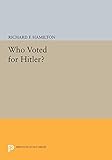Who Voted for Hitler? / Richard F. Hamilton.
Material type: TextSeries: Princeton Legacy Library ; 705Publisher: Princeton, NJ : Princeton University Press, [2014]Copyright date: ©1982Edition: Course BookDescription: 1 online resource (682 p.)Content type:
TextSeries: Princeton Legacy Library ; 705Publisher: Princeton, NJ : Princeton University Press, [2014]Copyright date: ©1982Edition: Course BookDescription: 1 online resource (682 p.)Content type: - 9780691614366
- 9781400855346
- 324.943/085 324.943085
- JN3838 .H35 2014
- online - DeGruyter
- Issued also in print.
| Item type | Current library | Call number | URL | Status | Notes | Barcode | |
|---|---|---|---|---|---|---|---|
 eBook
eBook
|
Biblioteca "Angelicum" Pont. Univ. S.Tommaso d'Aquino Nuvola online | online - DeGruyter (Browse shelf(Opens below)) | Online access | Not for loan (Accesso limitato) | Accesso per gli utenti autorizzati / Access for authorized users | (dgr)9781400855346 |
Frontmatter -- Contents -- Maps and Tables -- Abbreviations and Names -- Acknowledgments -- Chapter One. The Problem: Who Voted for Hitler? -- Chapter Two. A Review of The Literature -- Chapter Three. A Reconsideration of Previous Evidence -- Chapter Four. Berlin -- Chapter Five. Hamburg -- Chapter Six. Cologne and Munich: A Second Pattern -- Chapter Seven. Cities of The Ruhr -- Chapter Eight. Five Other Cities -- Chapter Nine. The Summer Election: Travelers and Vacationers -- Chapter Ten. The Parties of The Right and Center -- Chapter Eleven. The Parties of The Left -- Chapter Twelve. The National Socialists -- Chapter Thirteen. The Character of The Political Struggle -- Chapter Fourteen. The Weimar Catastrophe -- Appendix A. The Reichstag Elections: 1919-1933 -- Appendix B. Germany's Largest Cities -- Appendix C. Occupational Structures of The Cities Studied in Chapters 4-8 -- Notes -- Name Index -- Subject Index
restricted access online access with authorization star
http://purl.org/coar/access_right/c_16ec
Challenging the traditional belief that Hitler's supporters were largely from the lower middle class, Richard F. Hamilton analyzes Nazi electoral successes by turning to previously untapped sources--urban voting records. This examination of data from a series of elections in fourteen of the largest German cities shows that in most of them the vote for the Nazis varied directly with the class level of the district, with the wealthiest districts giving it the strongest support.Originally published in 1982.The Princeton Legacy Library uses the latest print-on-demand technology to again make available previously out-of-print books from the distinguished backlist of Princeton University Press. These editions preserve the original texts of these important books while presenting them in durable paperback and hardcover editions. The goal of the Princeton Legacy Library is to vastly increase access to the rich scholarly heritage found in the thousands of books published by Princeton University Press since its founding in 1905.
Issued also in print.
Mode of access: Internet via World Wide Web.
In English.
Description based on online resource; title from PDF title page (publisher's Web site, viewed 30. Aug 2021)


